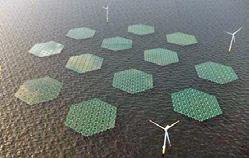
4 minute read
Hybrid generation
BRIEFS
Cadeler changes management
Offshore wind services and operations firm Cadeler has promoted Peter Kragh Jacobsen to CTO, where he will be responsible for the company’s newbuilt vessel programme. Jacobsen previously worked as CTO at Maersk Supply Service, where he worked for more than eight years. Maersk Supply provides vessels and solutions to the offshore energy industry. Other changes include Carina Cappelen as chief people & culture offier and Pernille Korsager as general counsel.
Prysmian to do 134km cable lay
Prysmian Group has announced it has won a €60 million contract to lay submarine cables for a new HVDC project in the United Arab Emirates. It will design, supply, assemble and test a monopole system of four HVDC single-core cables with XLPE fibre insulation and fibre optic cable systems to connect the Al Mifra onshore converter station to an offshore artificial island in the Arabian Gulf.
Huisman to supply gripper for Japan
Heavy construction manufacturer Huisman will deliver its first monopile gripper to Japan, also the first of its kind to be used in Japan. Construction firms TOA Corporation and Obayashi have placed the order, which comes a couple of years after Huisman delivered a 1,250t pedestal mounted crane for the firms, mounted on a self-elevating platform. The crane and the gripper communicate through software controls.
HYBRID OFFSHORE WIND AND SOLAR PROJECT AGREED
Energy giant RWE will develop more than 760MW of offshore wind power with a 5MW solar generation demonstrator alongside.
SolarDuck, a solar energy firm, will install floating solar panels at the Hollandse Kust West VII (HKW) project, which “catapults the Dutch-Norwegian company towards commercialisation and accelerates the scaling up of manufacturing assembly and installation,” the company says.
SolarDuck will also install integrated energy storage with its solar panels, although no details of this were given.
“This is a flagship project for SolarDuck and an important milestone for the wider offshore floating solar (OFS) industry,” said SolarDuck CEO Koen Burgers. “SolarDuck, being the first to build a hybrid project at this
8 SolarDuck and Hollandse Kust
West VII
scale, will demonstrate the robustness of our solution, prove the important role of system integration in building future-fit energy systems, and enable the scaling of the technology to accelerate its adoption.”
SolarDuck says its technology ‘provides an answer to increasing land scarcity for the generation of renewable energy’. ”Taking solar farms offshore requires a technology which is able to withstand rough offshore conditions, including high waves, strong winds and a corrosive environment,” the company says. ”SolarDuck´s unique shaped platform, which has received the world’s first certification for offshore floating solar by Bureau Veritas, is designed to float several metres above the water, following the waves like a carpet, therefore keeping critical electrical components dry, clean and stable, as well as securing the integrity of the semisubmersible structure while enabling safe operations and minimal maintenance.”
According to intelligence firm 4COffshore, 48 applications were made for the Hollandse Kust West VII permit, 27 of which met the application requirements. The highest scoring party of those 27, RWE, was given the permit to build, operate and then remove the wind farm.
JAN DE NUL PERFORMS REFUGEE RESCUE
Marine engineering giant Jan de Nul extended the hand of rescue to a small boat of Syrian refugees drifting in the Mediterranean 75km off the Algerian coast last week.
Crew on board the rock installation Simon Stevin were alerted by the small craft, whose engine had broken down and which had been drifting for several days, Jan de Nul said. Two women, five children and eight men were on the sloop and had come from Syria, press contact Heleen Schellinck said. They were all in good health apart from being cold and weak, she said.
“The refugees were recovered from their small craft into the rescue boat of our Simon Stevin, after which they approached the vessel to board,” she said.
They were given food, blankets and warm clothing and spent the night on the installation vessel before being taken to the harbour of Oran, where the Algerian coastguard took over.
Simon Stevin had been working at the Sakaryha gas field in the Black Sea, which is 100% owned by Turkey and which is expected to meet about 30% of domestic natural gas demand, with first production beginning in the first quarter of next year. The vessel was returning to Belgium when it made the rescue.
FUGRO AWARDED MAJOR OFFSHORE WIND CONTRACT
Fugro has secured a contract with Energinet for geotechnical site investigations for the North Sea I offshore wind development.
This award follows Fugro’s success working on the North Sea Energy Islands project for Energinet throughout 2022, a project that is the first of its kind. ”Our integrated services and innovative technology allow us to unlock insights for the safe, efficient and sustainable development of offshore windfarms. We’re proud to continue working with Energinet and support the renewables industry in Denmark,” said Erik-Jan Bijvank, group director Europe & Africa, Fugro. ”This award is in line with the strong growth in Fugro’s offshore wind activities during the past quarters. Our unique positioning is emphasised by clients seeking to secure capacity, also beyond the coming 12 months.”
The Danish government plans to expand offshore wind capacity by 4GW by 2030 and the geo-data acquired by Fugro during this new contract will be used to inform future bids in the area.
Fugro’s geo-data will provide crucial insights on the seabed and sub-surface conditions, reducing uncertainty and helping installers make informed decisions on where best to position the wind turbines and export cables.
With fieldwork set to start in 2024, Fugro will mobilise multiple geotechnical vessels equipped with state-of-the-art investigation tools such as the SEACALF Mk V Deepdrive system for seabed cone penetration tests and the WISON Mk V Ecodrive.
The fieldwork is expected to continue well into 2025, with further processing, laboratory testing and reporting of results to follow.









